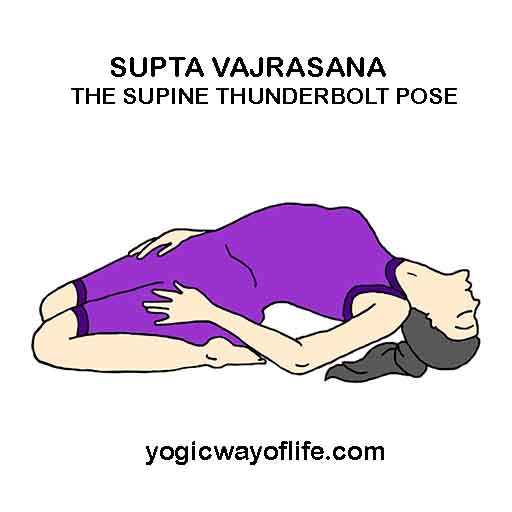Supta Vajrasana or the ‘Supine Thunderbolt Pose’ is a variation of Vajrasana or the thunderbolt pose. The starting position for supta vajrasana is same as vajrasana, but the ultimate position looks very different.

How to do Supta Vajrasana ?
- Sit in vajrasana, the thunderbolt pose, also called the kneeling pose. In this pose, the knees are kept close together, legs bent and buttocks resting on the lower legs and heels. The toes are crossed and touching each other.
- Once the vajrasana position is taken, slowly bend backwards, supporting the body weight using your arms and elbows, till the back of the head touches the ground.
- Now arch the back and rest the hands (palms) on the thighs. The elbows will continue to rest on the ground to support the weight of chest and abdomen.
- Breathe normally and deeply in a rhythmic manner.
- Close the eyes and relax all the muscles of the body.
- Remain in this position, as long as it is comfortable.
- While performing this asana, the thigh muscles are stressed and may cause pain in the initial stages, especially if they are stiff. With practice, as the thigh muscles become more flexible and the pain will go away.
- This asana stretches the entire spine and puts pressure on the neck and sacral regions. Those suffering from spondylitis, sacral pain and other spinal defects should seek expert advice before attempting this asana.
Benefits of Supta Vajrasana
- Supta vajrasana stretches the abdominal and thoracic muscles.
- It relieves constipation.
- It strengthens the thigh muscles.
- It can strengthen the sacral region and brings flexibility to the back, but those suffering from sacral pain should avoid this asana.
- It brings flexibility of the spine.
- It is a good counter-pose for forward bending asanas.
Variation of Supta Vajrasana
There is a variation of Supta Vajrasana where the head doesn’t rest on the floor. The basic method is the same as mentioned above. But the difference is that, the hands are folded and kept behind the back of the head. The head rests on the folded hands. In this variation the elbows don’t support the weight. Instead, the back is rested on the floor giving more stretch to the lower abdominal region. This variation puts no pressure on the neck, but the pull on the abdominal muscles are increased.
